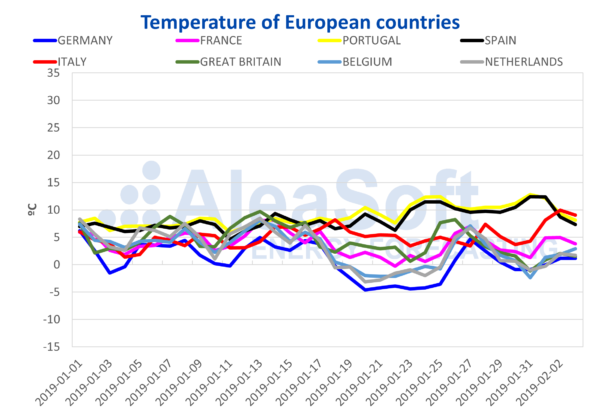Brent, fuels and CO²
The price of Brent oil futures in the ICE market for April started the week with a slight trend to exceed $63/bbl (barrel) after three weeks ranging between $60 and $62, although in general the trend is stationary. The situation in Venezuela remains a latent factor that is destabilizing the oil market. At AleaSoft, we consider, taking into account the slowdown in the growth of the economy, Brent will continue on the path of $60/bbl in the mid-term.
TTF gas futures for March fell below €20/MWh ($22.84) in early February for the first time since mid-April. Highs were reached in September at close to €30/MWh. At the beginning of this year, these futures were at €22.17 /MWh confirming a downward trend that can continue.
API 2 coal futures for March continue in the same way, with a slight downward trend and the possibility of falling below $77/ton. At the beginning of October, they were trading above $100/ton. At the beginning of the year they were at $84.80/ton.
As discussed by AleaSoft last week, the downward trend in gas and coal that has continued can influence declines in the prices of European electricity markets in the coming weeks when weather conditions are more favorable as temperatures rise.
On futures prices of CO² emission rights, for the reference month of December 2019, the last closing value, on Friday, was just under €22/ton. This year began with values above €25/ton that fell rapidly to €22.04/ton on January 19, before climbing to a high at €25.20/ton on January 22. AleaSoft considers €22/ton an equilibrium value.
European electricity markets
At the end of January, the prices of the main European markets rose on the values seen 12 months earlier from more than 20% for the MIBEL market in Spain and Portugal and the N2EX market in Great Britain, up to 75% on the EPEX SPOT in France, with values of around 65% in the case of EPEX SPOT Germany, EPEX SPOT Belgium and Nord Pool. In the case of the IPEX market in Italy, the year-on-year increase was 38% and the EPEX SPOT in the Netherlands was up 50%.
In all cases, electricity demand grew in January on a year-on-year basis, due to the drop in temperatures in those European countries of between 2°C and 3°C.



In the last week, from the end of January to the beginning of February, the prices of the European markets remained high at between €50 and €60/MWh, with a slight decrease compared to the average values seen in January. The drop in prices in Spain and Portugal is mainly due to high wind energy production. In both cases, prices fell to around €38/MWh by Saturday.
AleaSoft considers, taking into account the evolution of fuels, CO² and temperature forecasts for the coming weeks, prices should fall to a path of around €50/MWh.



Electricity futures
The electricity futures of France and Germany in the EEX market for March have followed a downward trend since the end of last year. In the case of French futures, on December 17 they closed at €60.05/MWh and on Friday were traded €9.83/MWh lower, at €50.22/MWh. For its part, the futures of Germany for March were traded on December 17 at €54.17/MWh and on Friday at €47.06/MWh – €7.11/MWh lower.
Spanish and Portuguese futures on the OMIP market have also maintained a bearish trend since the end of December. On December 17, the futures of Spain for March were traded at €59.83/MWh and those of Portugal at €59.99, and on Friday they were traded at €52.10/MWh and €51.73/MWh, respectively – a difference of around €8.
The decline in electricity futures for March is common across European markets. UK futures in the ICE market decreased £11.31/MWh ($14.64) between December 17 – when they were trading at £64.40/MWh – and Friday, when they were trading at £53.09/MWh. Those in the Netherlands – also on the ICE market – dropped €11.45/MWh on the same dates, from €62.59 to €51.14/MWh. In Belgium, also on the ICE market, futures fell €8.92/MWh, from €60.74 on December 17 to €51.82 on Friday, and those of Italy, in the EEX market, retreated €9.13/MWh, from €67.73 on December 17 to €58.60/MWh on Friday.
However, the futures of the Nordic countries on the ICE market for March did not follow the downward trend; since the second half of December they had been stationary at around €54-55/MWh and in the week of January 28, began to fall to €50.46 by Friday.
Outlook for the European electricity markets in 2019
As shown in the following table, the prices of fuels and CO² emissions have been rising since 2016.

That led to an increase in prices in 2017 and last year.

European electricity prices went in two years from an annual band of €30-50/MWh in 2016 to €45-65/MWh, in the markets with less prices and also the more expensive ones. In the two years since 2016, the increase in the average annual CO² price was around €10.50/ton, gas was at €8.70/MWh and coal $32/ton.
For this year, fuel and CO² prices are not expected to decrease on 2018 figures. The trend will be for a continuation of high European electricity market prices.
